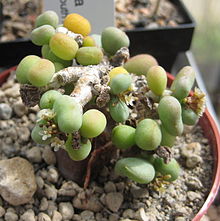| Portulacaria | |
|---|---|

| |
| Portulacaria afra | |

| |
| Mature Portulacaria afra | |
| Scientific classification | |
| Kingdom: | Plantae |
| Clade: | Tracheophytes |
| Clade: | Angiosperms |
| Clade: | Eudicots |
| Order: | Caryophyllales |
| Family: | Didiereaceae |
| Subfamily: | Portulacarioideae |
| Genus: | Portulacaria Jacq. |
Portulacaria is a genus of succulent plant, classified in its own subfamily Portulacarioideae in the family Didiereaceae. It is indigenous to southern Africa.
Taxonomy[edit]
The genus was previously placed in the family Portulacaceae, but according to molecular studies is part of Didiereaceae.
It has further been revised when phylogenetic tests showed conclusively that genus Ceraria was located within Portulacaria, and all Ceraria species have consequently been renamed and moved into this genus.[1]
Species[edit]

As of March 2024[update], Plants of the World Online accepted the following species:[2]
- Portulacaria afra Jacq.
- Portulacaria armiana van Jaarsv.
- Portulacaria carrissoana (Exell & Mendonça) Bruyns & Klak, syn. Ceraria carrissoana Excell & Mendonca
- Portulacaria fruticulosa (H.Pearson & Stephens) Bruyns & Klak, syn. Ceraria fruticulosa Pearson & Stephens
- Portulacaria longipedunculata (Merxm. & Podlech) Bruyns & Klak, syn. Ceraria longipedunculata Merxm & Podlech
- Portulacaria namaquensis Sond., syn. Ceraria namaquensis Sond.
- Portulacaria pygmaea Pillans, syn. Ceraria pygmaea Pillans
Uses[edit]
Portulacaria afra normally uses C3 (or Hatch-Slack) carbon fixation but is also able to switch to CAM carbon fixation when drought stressed.
It is a local delicacy and its leaves are eaten by the local peoples. It is also popular internationally as a garden plant.[3] Because of its superficial resemblance to some species in the family Crassulaceae, most of which are toxic,[4] the two are readily, and possibly dangerously, confused by people unaware of the differences.
References[edit]
- ^ P.Bruyns, M.Oliveira-Neto, G.F. Melo de Pinna, C.Klak: Phylogenetic relationships in the Didiereaceae with special reference to subfamily Portulacarioideae. Taxon 63 (5). October 2014. 1053-1064.
- ^ "Portulacaria Jacq." Plants of the World Online. Royal Botanic Gardens, Kew. Retrieved 2024-03-17.
- ^ Guralnick, L. J.; Ting, I. P. (1987). "Physiological Changes in Portulacaria afra (L.) Jacq. during a Summer Drought and Rewatering". Plant Physiology. 85 (2): 481–6. doi:10.1104/pp.85.2.481. PMC 1054282. PMID 16665724.
- ^ Watt, John Mitchell; Breyer-Brandwijk, Maria Gerdina: The Medicinal and Poisonous Plants of Southern and Eastern Africa 2nd ed Pub. E & S Livingstone 1962
Well, that’s interesting to know that Psilotum nudum are known as whisk ferns. Psilotum nudum is the commoner species of the two. While the P. flaccidum is a rare species and is found in the tropical islands. Both the species are usually epiphytic in habit and grow upon tree ferns. These species may also be terrestrial and grow in humus or in the crevices of the rocks.
View the detailed Guide of Psilotum nudum: Detailed Study Of Psilotum Nudum (Whisk Fern), Classification, Anatomy, Reproduction